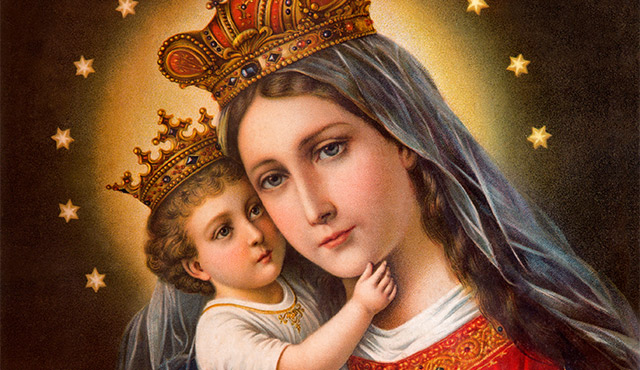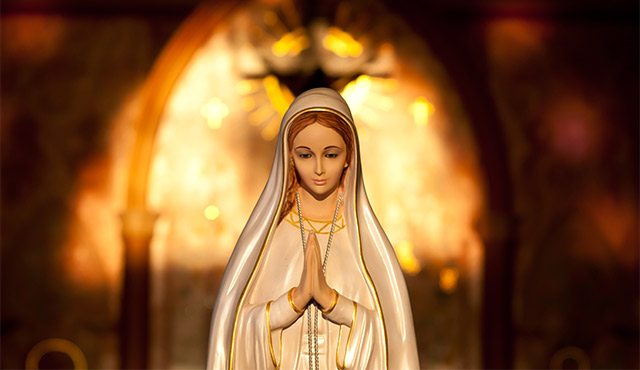Every May, Catholics all over the world celebrate the mother of all mothers as they make a series of private Marian devotions to Jesus Christ’s mother, the Blessed Virgin Mary, who is honored as May’s Queen.
Devotions include making small sacrifices in Mary’s honor, singing Marian hymns, praying the rosary, reciting the “Hail Mary” and reading and reflecting on Scripture related to Mary. There are public devotions at churches and Catholic schools, such as crowning the Blessed Virgin Mary’s image or statue with flowers, making pilgrimages, visiting churches dedicated to her, publicly reciting the rosary or creating a May altar in a church or a house that’s decorated with spring flowers.
The last public devotion on May 31 is often a solemn procession during which a statue or portrait of the Virgin Mary is carried back into the church.
“It’s a nice way to honor Mary and to give children an opportunity to participate in that,” said Michael P. Donaldson, director of Pastoral Care for Families in All Stages for the Diocese of Orange. “She is the queen of heaven and earth. It’s a practice that brings a lot of joy to people.”
The month-long devotion to Mary is a tradition that goes back to the 13th century, when Alfonso X of King Castile wrote in his “Cantigas de Santa Maria” about the special honoring of Mary during specific dates in May. By 1739, there was talk of a particular form of Marian devotion in May in Grezzano, near Verona. Eight years later, the Archbishop of Genoa recommended the May devotions for the home. By 1838, specific prayers for Mary were formally proclaimed in Rome, and the devotional practice of honoring Mary during the month of May spread ultimately around the Roman Catholic world in the 19th century.
Finally, in his 1965 encyclical, “Mense Maio,” Pope Paul VI recognized the month of May as an appropriate time to include special prayers for peace into traditional May devotions. “Eventually, the entire month was filled with special observances and devotions to Mary,” said Deacon Guillermo Torres, director of the Office for Hispanic Ministry for the Diocese of Orange.
There are also many references to Mary and her motherhood to the church, Torres said.
In Roman Catholic Mariology, the title, “Mother of the Church (Mater Ecclesiae)” was used by Pope Benedict XIV in 1748, then by Pope Leo XIII in 1885. It also was also used by Saint Pope John Paul II and is also found in the Catechism of the Catholic Church.
The title, “Mother of the Church,” was officially given to Mary during the Second Vatican Council by Pope Paul VI. “The faithful first called upon Mary with the title, ‘Mother of God,’ ‘Mother of the faithful’ or ‘our Mother,’ to emphasize Mary’s personal relationship with each of her children,” Torres said. “Later, because of the greater attention paid to the mystery of the Church and to Mary’s relationship to her, (she was) invoked as ‘Mother of the Church.’”
While secular in nature and having no liturgical significance for the Church calendar, Mother’s Day – on May 8 this year – honors not only mothers living and deceased, but also honors the Blessed Virgin Mary, who is considered “our mother, empress, and teacher in the spiritual life,” Torres said.
“We could say, unofficially, of course, that Mary is the patroness of Mother’s Day,” Torres said. “Mary teaches all mothers the dignity and the value of all human life. She teaches mothers to be generous, loving and compassionate to their children and to all they meet. Mary teaches mothers how to be models of deep faith and great courage as they face the joys and challenges of family life today. On this Mother’s Day, we pray that the Blessed Virgin Mary will wrap her mantle around all mothers, and through her powerful intercession, strengthen them in their maternal role.”
Donaldson said that the tradition of honoring Mary in the same month as Mother’s Day makes a lot of sense. “It’s the month of spring, of new life and new hope,” he said. “That’s what she represents, so it’s fitting that that tradition came about. Mary is not just the mother of Jesus, but the mother of us all. What better person to celebrate in the month of mothers than our Blessed Mother?”
A great way to remember Mary is to read about her life, Donaldson said. One of his favorites is Mary’s biblical appearance at a wedding feast in Cana in which she tells Jesus there is no more wine. The scene, in which Jesus performs his first public miracle by producing more wine, showcases Mary’s belief in her son. “She’s known to be a woman of true faith,” he said.
And while May is deemed the month of Mary, one’s devotion to the Blessed Virgin Mary should go beyond this month, Donaldson said. “We should incorporate her in our everyday life, whether it’s in evening prayer or in images of her around the house or reading about her life,” he said. “It’s telling your kids that she is there to guide them to her son and help them live a life that is holy.”


